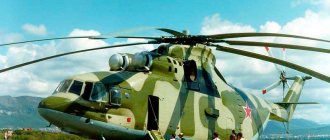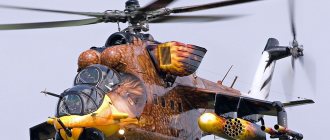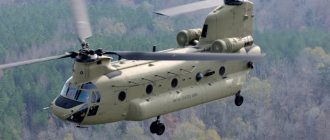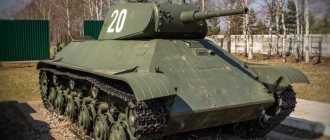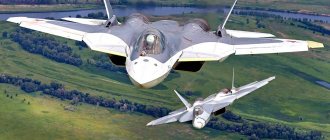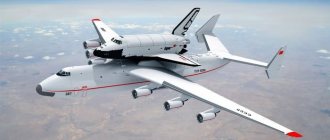The development of the Mi-6 heavy airborne transport helicopter, which began in 1953, determined the leadership of the domestic helicopter industry in the development of heavy helicopters for many years. The Mi-6 helicopter, in its flight performance characteristics established by the combined tactical-technical military and civilian requirements in 1954, significantly surpassed all foreign helicopters, representing a qualitative leap in the development of the world helicopter industry.
Mi-6 helicopter - video
The layout scheme used for the Mi-6 helicopter with two gas turbine engines and a fuselage with a large cargo compartment and rear cargo hatch has become classic, repeated in many domestic and foreign helicopters, and a unique main rotor with a diameter of 35 m has been developed, ensuring the take-off of a helicopter with a maximum take-off weight of 48 tons, and the main gearbox, transmitting a power of 8090 kW from two gas turbine engines, were outstanding achievements of science and technology. To ensure high flight speeds on the Mi-6 helicopter, a combined load-bearing system with a wing unloading the main rotor was used.
The first of five experimental helicopters made its first flight on June 5, 1957, and on October 30 of the same year, the experimental Mi-6 helicopter set an international record for lifting a maximum load of 12004 kg to a height of 2432 m, indicating the enormous potential capabilities of the helicopter and marking the beginning of outstanding absolute international records , installed on the Mi-6.
During joint tests of the Air Force and the State Committee on Aviation Equipment, carried out in 1959-1963, 16 international records were set, including absolute records: lifting a load of 5000 kg to a height of 5584 m and a maximum load of 20117 kg to a height of more than 2000 m; speed 300.377 km/h along a closed route of 1000 km with a load of 5000 kg; speed 315.657 km/h along a closed route of 500 km; a speed of 320 km/h on a base of 15-25 km and, finally, a speed of 340.15 km/h on a closed route of 100 km, established on August 26, 1964 and remaining unsurpassed to this day. These records made the Mi-6 helicopter not only the most load-lifting, but also the fastest helicopter in the world. In 1961, for the absolute speed record of 320 km/h, set on the Mi-6 helicopter, the American Helicopter Society design bureau M.L. Mil was awarded the International Prize named after I.I. Sikorsky "as recognition of an outstanding achievement in the development of helicopter art."
At the end of 1959 Serial production of Mi-6 helicopters began at the Rostov Helicopter Plant, which continued until 1981, as well as at the plant named after. Khrunichev in Moscow; In total, 860 helicopters were built in military and civilian versions, delivered to the Soviet armed forces and civil aviation, as well as abroad: to Vietnam, Egypt, India, Indonesia, Iraq, China, Peru, Poland, Syria and Ethiopia. A version of the Mi-22 has been developed - an aerial observation post with a large antenna on the tail boom.
History of creation
The successful development and launch into mass production of the Mi-4 transport helicopter allowed chief designer Mil and his subordinates to believe in themselves and begin implementing even more ambitious projects. Having analyzed the development trends of the ground forces of that time, the design bureau specialists concluded that the next stage in the development of helicopter engineering should be a machine with a payload capacity of at least six tons.
The designers were aware of the complexity of the task facing them: in those years, both in the USSR and abroad, attempts were made to create a helicopter with a take-off weight of more than 14 tons, but all of them were unsuccessful.
Work on the new machine began in 1952, but development officially began only on July 11, 1954, after the corresponding government decree was issued. It instructed the designers to create a helicopter with the following technical characteristics: speed - 300-350 km/h, ceiling - 6 thousand meters, load capacity - 6 tons (8 tons when overloaded).
State tests of the new helicopter were to begin in 1957.
Initially, there were many questions regarding the layout of the future machine. Most experts of that time did not believe that a heavy helicopter could be built according to the classical design with one main rotor. However, Mil chose it for his new helicopter. To do this, the machine had to be equipped with a rotor with an unprecedented diameter - more than thirty meters.
During this period, the United States associated the increase in the lifting capacity of helicopters with the further improvement of piston engines, but Soviet engineers came to the conclusion that it was more advisable to use gas turbine engines for the new machine. It was planned to install a TV-2F engine on the helicopter; P. A. Solovyov was involved in its modification.
The preliminary design of the helicopter was approved in June 1955. After this, construction of the prototype began. She received the designation Mi-6. On June 18, 1957, the new heavy helicopter took off for the first time. On October 30, 1957, the Mi-6 lifted a load of 12 tons to a height of 2432 meters. This achievement became a worldwide sensation and was twice as great as the achievement of the American S-56 cargo helicopter.
In 1959, serial production of the new helicopter was launched at Rostov plant No. 168, where it continued until 1980.
It cannot be said that the development of the new car proceeded quickly and smoothly. The Mi-6 was truly a unique helicopter that had no analogues before. Therefore, the car had enough flaws and defects. After the first stage of testing, it became clear that the helicopter did not meet the characteristics specified by the customer. There was not enough speed, altitude and flight range, however, the Mi-6’s carrying capacity turned out to be beyond praise.
The most problems were with the main and tail rotor blades. The developers proposed a fundamentally new design for the main rotor blades: sections that were not connected to each other were attached to a metal spar. This made it possible to significantly reduce the loads during the overall bending of the blade.
The development of a new tail rotor, which was made of delta wood, made it possible to increase the helicopter's speed to 270 km/h.
Quite a lot of time and effort was spent on finalizing the D-25V turboshaft engine.
State tests of the Mi-6 were completed only in 1962, while these helicopters had long been used in combat units. And it must be said that the operation was accompanied by significant difficulties. At that time the car was still very “raw”. There were accidents and disasters.
In 1960, new rotor blades with honeycomb filling were developed for the Mi-6. Soviet industry had a very hard time mastering this new technology. New blades made it possible to significantly increase the speed, flight range and ceiling of the machine. Their resource was also significantly increased (up to 500 hours).
In 1964, the first export deliveries of the Mi-6 began. In the USSR, this helicopter was widely used in various sectors of the national economy: as a cargo and passenger vehicle, an ambulance helicopter, during search and rescue operations and firefighting. At the end of the 50s, the Luna mobile missile system was adopted by the Soviet army, and the Mi-6 was used to transport it.
Over time, numerous modifications of the Mi-6 were developed for the military: an anti-submarine helicopter, an air command post, a tanker and an electronic jamming helicopter.
In the 60s, not a single major exercise of the Soviet armed forces was complete without the use of the Mi-6.
This helicopter was not intended to perform strike missions, but an experimental version of the vehicle was created with rockets on external slings. The Mi-6 took part in several conflicts, but its main function remained transport. Mi-6s took part in the Vietnam War, were used in the Middle East, and Soviet troops used this helicopter in Afghanistan. The last conflict in which the Mi-6 had to take part was the Chechen campaign. These helicopters transported ammunition and fuel to the front line and evacuated wounded and dead soldiers.
The accidents and catastrophes that happened to the Mi-6 were overwhelmingly associated with the human factor - the “six” turned out to be a fairly reliable machine. In 1996, a helicopter crash occurred in the Leningrad region, after which Mi-6 flights were suspended for a long time. The flights of this aircraft were finally banned only in 2002, and even then this order did not apply to the use of the Mi-6 in the North Caucasus. The official end of helicopter operation in Russia is considered to be 2004, although helicopter use continues in other countries.
Design
The helicopter is made according to a single-rotor design with a wing, two gas turbine engines and a tricycle landing gear.
Fuselage
All-metal, frame construction. In the bow there are cockpits, the front one for the navigator, the middle one for two pilots and the rear one for the radio operator and flight engineer. In the central part of the fuselage there is a cargo compartment with dimensions of 12 x 2.65 x 2.5 m and a volume of about 80 m3, a cargo hatch with dimensions of 2.65 x 2.7 m with side-opening doors and a cargo ladder, designed to transport cargo weighing up to 12 tons, or up to 65 passengers on folding doors. seats (in extreme situations, up to 150 passengers were transported in the cabin), or 41 wounded on stretchers with two orderlies on folding seats; There is a door and nine windows on the right side of the cabin, and two doors and seven windows on the left side. In the floor of the cargo compartment there is a cargo hatch that can be closed with doors.
Tail boom
Semi-monocoque design, detachable, bolted to the fuselage, ending in an end beam. A controlled stabilizer is installed on the tail boom, and a fixed rudder is installed on the end boom.
Wing
Split, it has a center section beam and consoles with a caisson-type spar, bow and tail sections and an ending. The wing is designed for a maximum load equal to 25% of the flight weight, has a TsAGI P35 profile with a relative thickness at the root of 15% and at the tip of 12%. The left console has a wedge angle of 14°15′, and the right one has a wedge angle of 15°45′.
Chassis
Three-support, non-retractable, with liquid-gas shock absorbers; front support with two castor wheels measuring 720 x 310 mm; the main supports of the shaped type have one brake wheel each with dimensions of 1320 x 480 mm and a pressure of 7 kg/cm2; there is a tail support on the tail boom; The landing gear allows for vertical and airplane-type takeoff and landing.
Rotor
Five-bladed, with hinged blades and hydraulic dampers, tilted forward by 5°. The blades are of an all-metal structure, rectangular in plan, with NACA 230M and TsAGI profiles with a relative thickness of 17.5% at the tip and 11% at the tip and a twist angle of 6°. Blade chord 1m. The blades have a steel spar made of a single cold-rolled pipe made of 40ХНМА steel, 15.61 m long, with different wall thicknesses and cross-sectional shapes. 20 sections are attached to the spar, consisting of a nose section with a counterweight and anti-icing package, a tail section with honeycomb core, and an end fairing. The blades have an electric anti-icing system, the peripheral speed of the blade tips is 220 m/s.
Tail rotor
Four-blade, pusher/diameter 6.3m with trapezoidal blades in plan, with NACA 230 profile and variable relative thickness. The blades are wooden, with a delta wood spar and a steel tip, have a toe cap and an anti-icing system.
Power point
It consists of two GTD-25V turboshafts produced by Perm NPO Aviadvigatel with a free turbine, installed side by side on top of the fuselage in a fairing; the engine has a nine-stage compressor and a two-stage turbine. Engine length 2.74 m, width 1.09 m, height 1.16 m, dry weight with all units 1344 kg, take-off power of the engine 4045 kW.
Fuel system
It is made according to a two-wire circuit, the fuel is contained in 11 soft tanks with a total capacity of 3250 liters, to increase the flight range it is possible to install two outboard tanks of 2250 liters each and additional tanks with a capacity of 4500 liters in the cargo compartment.
Transmission
Consists of main, intermediate and tail gearboxes, main rotor brake and fan drive. The R-7 main gearbox is four-stage and also provides fan drive for cooling the oil coolers, gearbox and engines.
Control system
Duplicated, with rigid and cable wiring and hydraulic boosters. The helicopter is equipped with an autopilot that provides stabilization for heading, roll, pitch and flight altitude.
Equipment
Two hydraulic systems with a pressure of 12.8-15.3 MPa provide drive for hydraulic boosters and control units, an auxiliary system provides drive for windshield wipers of cargo doors and ladders, etc. An air system with a pressure of 4.95 MPa serves to brake the wheels, control the air bypass flaps and the heating system. The helicopter is equipped with VHF and HF radio stations, SPU, radio altimeter and radio compass.
Armament
On some military helicopters, an A 12.7 machine gun with a 12.7mm caliber is installed in the bow on a limited-movable NUV-1V mount with a K-10T collimator sight.
Modifications
Mi-6A
Mi-6A - A new basic modification of the helicopter, created in 1971 as a result of numerous modifications
Mi-6ATZ - Tanker based on the Mi-6A transport helicopter
Mi-6VKP - Airborne command post.
Mi-6M - Basic anti-submarine helicopter, work on which began in 1958.
Mi-6P - Passenger modification of the helicopter (Salon), created in 1965.
Mi-6PZh
Mi-6PZh - Fire variant.
Mi-6PP - Jammer for electronic intelligence and detection systems of the AWACS type. Not mass-produced.
Mi-6PRTBV - Helicopter-type mobile missile and technical base.
Mi-6PS - Search and rescue helicopter.
Loading the 9P114 launcher with the 9M21 Luna-MV tactical missile into the Mi-6RVK cabin of the 9K53 missile and helicopter complex
Mi-6RVK - Rocket and helicopter complex.
Mi-6TZ - Tanker for ground forces and aviation.
Mi-10 - “Air crane”, a variant for transporting cargo on an external sling.
Mi-22 - (Mi-6AYA) Airborne command post.
Characteristics
| Modification | Mi-6 |
| Length, m | 33,18 |
| Height, m | 9,86 |
| Weight, kg | |
| empty | 26500 |
| normal takeoff | 39700 |
| maximum takeoff | 41700 |
| engine's type | 2 GTE D-25V |
| power, kWt | 2 x 4100 |
| Max. speed, km/h | 250 |
| Cruising speed, km/h | 200 |
| Practical range, km | 500 |
| Practical ceiling, m | 4500 |
| Crew, people | 5 |
| Payload: | 6 thousand kg in the cabin (up to 12 thousand kg) or 8000 kg |
| on external sling |
Accommodation
Typically one pilot sits on the left side of the flight deck. The air-conditioned cabin provides seating for 8 passengers - back-to-back benches for 3 people each, with two additional outboard seats on the starboard rear side, one behind the other. All passenger seats can be dismantled to transport up to 700 kg of cargo. Access to the cabin is via hinged doors on each side at the front of the cabin and aft on the port side. The pilot's sliding window is squeezed out in emergency situations. The rescue modification provides space for 4 stretchers and an orderly, or 2 stretchers and 2 seated patients. The training version has side-by-side seating and dual controls. Mi-2 is a helicopter with standard heating, ventilation and air conditioning systems.
Modifications
During its operation, the Mi-1 was repeatedly modernized, and numerous modifications were created. Here are the main ones:
- Mi-1. Basic modification of the machine that was put into operation. Could carry two passengers.
- Mi-1NX. A modification that was most actively used for civilian needs: transporting mail and passengers, transporting the sick and wounded, cultivating agricultural land. To perform each of the above tasks, a separate version of this helicopter was produced. The passenger version had additional space for one more passenger, the sanitary version had side removable gondolas, and the agricultural version had equipment for spraying fields.
- Mi-1U. A modification for pilot training, it was equipped with dual controls and a seat for an instructor, and was widely used in flight schools and in DOSAAF.
- Mi-1P. Modification equipped with floats for landing on water. Widely used by Soviet whalers.
- Mi-3. This machine is a deep modernization of the base model. It was made by order of the military and was used as an ambulance helicopter. The Mi-3 had a new four-blade main rotor, a more comfortable cabin, and gondolas for transporting the wounded.
- SM-1. This is a modification of the Mi-1, created in Poland by specialists from PZL Swidnik. The helicopters were manufactured entirely from Polish components; only the engine was Soviet.
- SM-2. Improved version of SM-1.
Initially, helicopters were used in the armed forces to provide communications, reconnaissance and surveillance, and evacuate the wounded from the battlefield. However, already in the 50s, the first attack helicopters appeared in the West. They tried to do something similar with the Mi-1. In 1958, a modification of the helicopter appeared, armed with two containers with TRS-132 unguided rockets. Later they tried to install machine guns, guided anti-tank missiles, and aircraft machine guns in hanging containers on the Mi-1.
Around the same time, they planned to make an anti-submarine helicopter from the Mi-1, but the power of its power plant was not enough to transport search equipment and weapons.
The most famous disasters
The history of the helicopter's operation includes two serious crashes of the Mi-6. The first of them occurred in Novoagansk on January 3, 1984. At that time, the vehicle was used to transport passengers and cargo as part of an oil field exploration expedition. She failed to gain the required altitude, as a result of which the helicopter hit the ground and, turning over to the left side, burned out. The tragedy led to the death of 38 passengers. As the results of the investigation into this incident showed, the cause of the incident was the excessive weight of the helicopter.
On December 11, 1990, another Mi-6 crashed near the Belarusian town of Korbin. The helicopter landed in very difficult weather conditions. The crew failed to control the aircraft, which resulted in the aircraft reaching a critical pitch angle. As a result, the car crashed to the ground and caught fire. All four crew members then died from their injuries.
Interesting Facts
At the design stage of the model design, it was envisaged that its total take-off weight should be 40 tons. The maximum value of this indicator among foreign analogues at that time was 15 tons.
The machine became the first helicopter in the USSR equipped with a gas turbine power plant.
The Mi-6 is a helicopter in which, for the first time in the history of Soviet aviation construction, the possibility of transporting cargo outside the fuselage was realized.
Helicopters of this model took an active part in eliminating the consequences of the disaster at the Chernobyl nuclear power plant in 1986.
Several copies of the helicopter are now at sites with radioactive equipment, since their use after participation in the above-mentioned operation would be dangerous.
TOP 3 most powerful combat helicopters in the world
Combat or attack helicopters are designed to destroy ground targets, including tanks, and air targets, including helicopters. They operate independently or accompany transport or landing helicopters.
Hughes AH-64 Apache
The Latin letters “AH” in the model name mean Attack Helicopter - attack helicopter.
During the life of the AH-64, the Hughes company was sold twice:
- In 1984 it was bought by MacDonald-Douglas;
- In 1997 - Boeing.
The AH-64 is a development of Bell's first attack helicopter, the AH-1 Cobra, which played an important role in Vietnam. But it differs quite seriously from it. The Cobra was designed primarily to fight Vietnamese guerrillas, while the Apache was designed primarily to fight Soviet tanks. The Apache is close to the Cobra in terms of characteristics: size and power, but carries significantly more weapons and electronics.
The eight-ton machine with a propeller with a diameter of 14.6 meters provides for the seating of two pilots in a tandem pattern: the first behind the second. At the same time, to ensure proper visibility, the first pilot sits 40 cm higher than the second. The Apache flies at a speed of 270 km/h over a distance of up to 690 km. To carry out combat missions, it is not only equipped with a 30 mm cannon and suspension mounts for mounting guided or unguided missiles, but it also carries an all-weather weapon system AAWWS (Longbow) with millimeter wave radar.
Today, the AH-64 Apache is the most common attack helicopter model in the world. More than 2,000 pieces were produced.
CAIC WZ-10
CAIC WZ-10 is a Chinese attack helicopter. It’s not a bad model, it’s not for nothing that the legendary Russian Kamov Design Bureau took part in its development. The Kamovites developed a preliminary design commissioned by the People's Republic of China. Then the Chinese acted on their own. And they pierced themselves in typical Chinese style. An unprecedented scandal broke out. The fact is that for many years it supplied engines for Chinese civilian helicopters. The Chinese also, as if nothing had happened, installed a Pratt & Whitney engine on the military WZ-10. They just modernized it a little: they uploaded a new version of the software. On this basis, the Chinese decided that Pratt did not need to seek export permission from the US government. But in court it was established that China hid that the engine was intended for an attack helicopter. CIAC passed off the program as a civilian project. Pratt received a multi-million dollar fine and was forced to stop supplying engines to China. Now the WZ-10 is equipped with a less powerful Chinese-made engine.
Kamov KA-52 "Alligator"
Initially they wanted to use the KA-60 Killer Whale helicopter, but in the heady nineties its development was practically stopped. Kamovites revised the concept and entrusted target designation to the two-seat KA-52, which was supposed to simultaneously perform two roles:
- command vehicle;
- independent attack helicopter.
This is how the KA-52 Alligator appeared. The prototype took off in 1997, regular operation began in 2008.
Unlike Chinese and American attack helicopters, our KA-52 crew members sit side by side. Each of them can both control the flight and use weapons. The outline of the Black Shark with a “two-story” column of rotors, characteristic of Kamov’s helicopters, has been preserved in the Alligator: starting from the 18th frame, the hulls of the models are identical.
Such a two-story column indicates that the helicopter is built according to a “coaxial” design, when two propellers rotate on the same axis, but in different directions. This eliminates the need for a vertical tail rotor. This design distinguishes the Ka-52 from all other models in this review. It has its advantages and disadvantages. Experts note that the coaxial design makes it easier to control the helicopter and improves its maneuverability. But this makes the car more complex and expensive.
